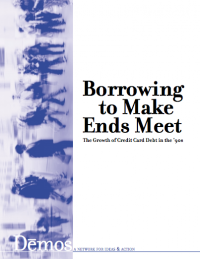This report explores how families are increasingly using credit cards to meet their basic needs. This report also examines the factors driving this record-setting debt and the impact of deregulation on the cost, availability and marketing of credit cards.
Executive Summary
The mid and late 1990s will always be remembered as an era of unprecedented prosperity. But for most American families, the roaring '90s had a dark underbelly -- it was also the Decade of Debt.
Between 1989 and 2001, credit card debt in America almost tripled, from $238 billion to $692 billion. The savings rate steadily declined, and the number of people filing for bankruptcy jumped 125 percent.
How did the average family fare? During the 1990s, the average American family experienced a 53 percent increase in credit card debt, from $2,697 to $4,126 (all figures measured in 2001 dollars). Low-income families saw the largest increase -- a 184 percent rise in their debt -- but even very high-income families had 28 percent more credit card debt in 2001 than they did in 1989.
Credit card debt is often dismissed as the consequence of frivolous consumption. But an examination of broad structural and economic trends during the 1990s -- including stagnant or declining real wages, job displacement, and rising health care and housing costs -- suggests that many Americans are using credit cards as a way to fill a growing gap between household earnings and the costs of essential goods and services. Usurious practices in the credit card industry, in the form of high rates and fees, have taken advantage of the increased need for credit. As a result, a growing number of American families find themselves perpetually indebted to the credit card industry, which -- despite claims of losses and chargeoffs -- remains one of the most profitable sectors of the banking industry.

